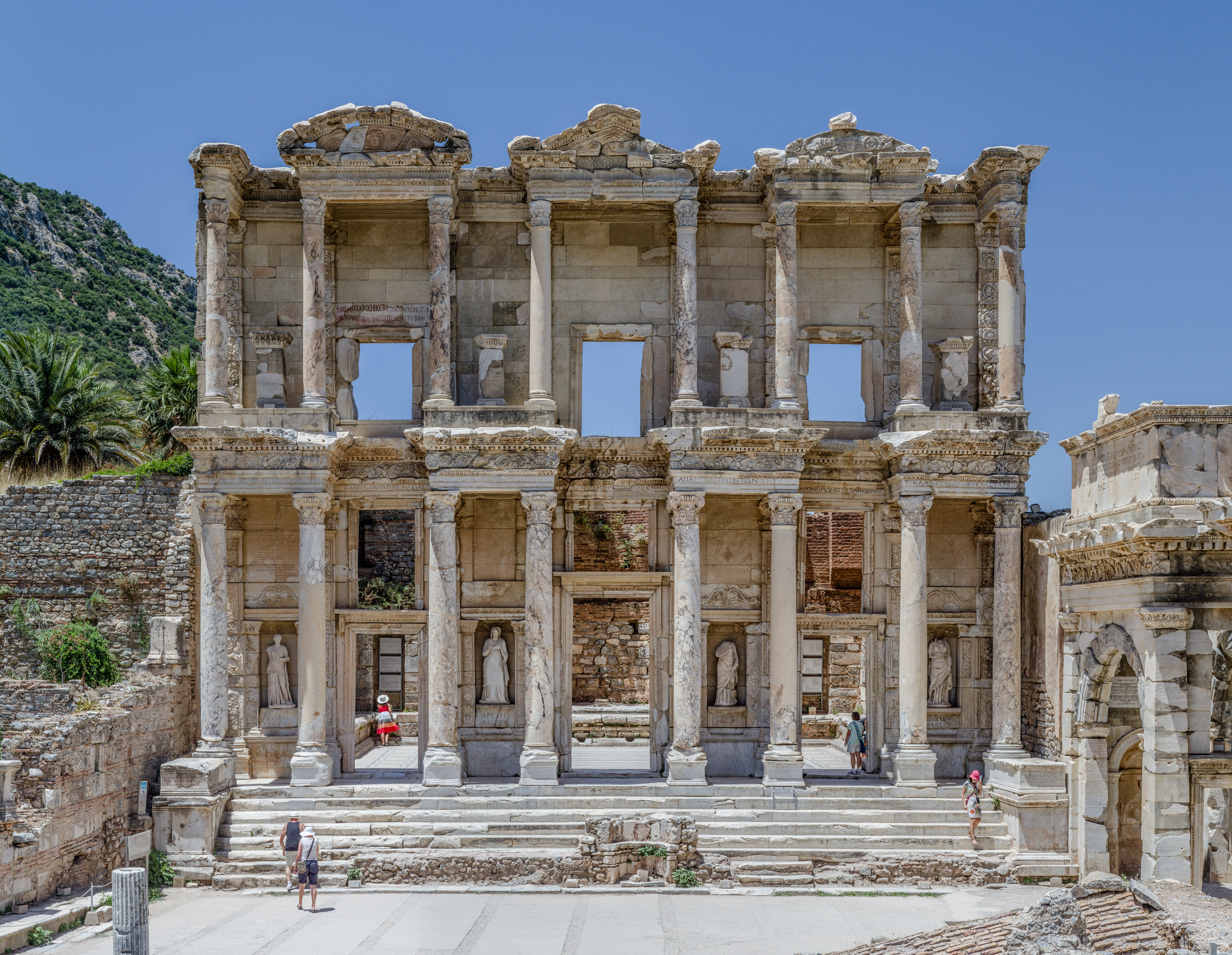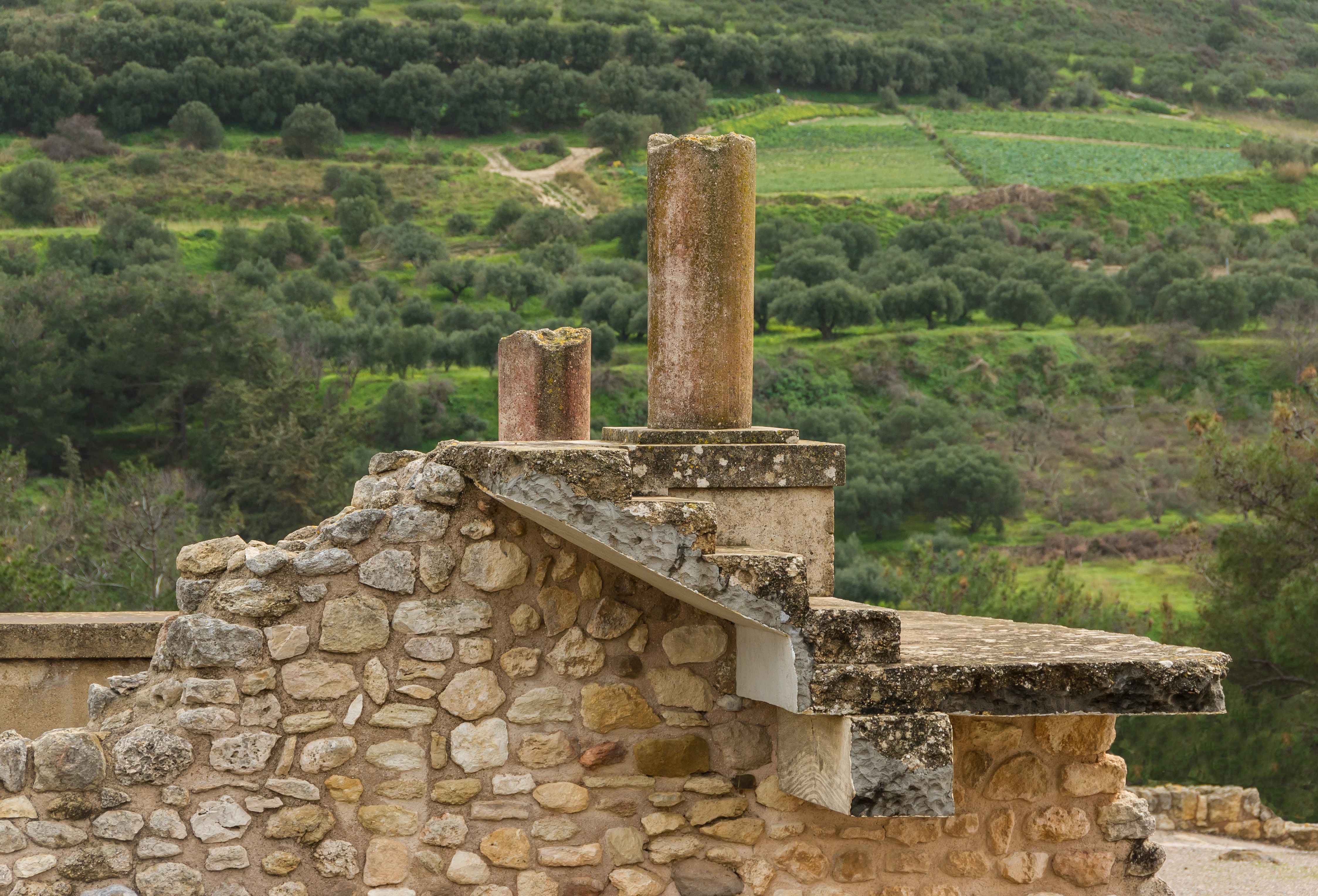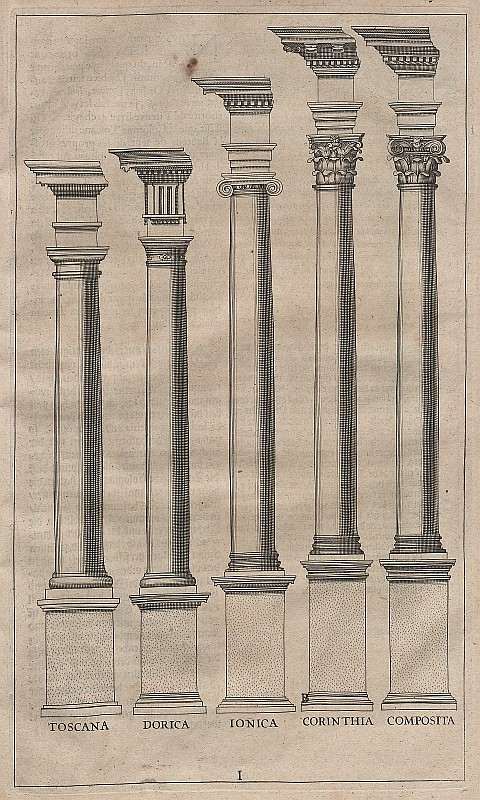|
Library Of Celsus
The Library of Celsus ( el, Βιβλιοθήκη του Κέλσου) is an ancient Roman building in Ephesus, Anatolia, now part of Selçuk, Turkey. The building was commissioned in the 110s A.D. by a consul, Gaius Julius Aquila, as a funerary monument for his father, former proconsul of Asia Tiberius Julius Celsus Polemaeanus, and completed during the reign of Hadrian, sometime after Aquila's death. The library is considered an architectural marvel, and is one of the only remaining examples of a library from the Roman Empire. The Library of Celsus was the third-largest library in the Roman world behind only Alexandria and Pergamum, believed to have held around twelve thousand scrolls. Celsus is buried in a crypt beneath the library in a decorated marble sarcophagus. The interior measured roughly 180 square metres (2,000 square feet). The interior of the library and its contents were destroyed in a fire that resulted either from an earthquake or a Gothic invasion in 262 A.D.,C ... [...More Info...] [...Related Items...] OR: [Wikipedia] [Google] [Baidu] |
Ephesus Celsus Library Façade
Ephesus (; grc-gre, Ἔφεσος, Éphesos; tr, Efes; may ultimately derive from hit, 𒀀𒉺𒊭, Apaša) was a city in ancient Greece on the coast of Ionia, southwest of present-day Selçuk in İzmir Province, Turkey. It was built in the 10th century BC on the site of Apasa, the former Arzawan capital, by Attic and Ionian Greek colonists. During the Classical Greek era, it was one of twelve cities that were members of the Ionian League. The city came under the control of the Roman Republic in 129 BC. The city was famous in its day for the nearby Temple of Artemis (completed around 550 BC), which has been designated one of the Seven Wonders of the Ancient World. Its many monumental buildings included the Library of Celsus and a theatre capable of holding 24,000 spectators. Ephesus was recipient city of one of the Pauline epistles; one of the seven churches of Asia addressed in the Book of Revelation; the Gospel of John may have been written there; Harris, Stephen ... [...More Info...] [...Related Items...] OR: [Wikipedia] [Google] [Baidu] |
Anastylosis
Anastylosis (from the Ancient Greek: ; , = "again", and = "to erect stela or building) is an archaeological term for a reconstruction technique whereby a ruined building or monument is restored using the original architectural elements to the greatest degree possible, combined with modern materials if necessary, ensuring that the latter are unobtrusive while clearly recognizable as replacement materials. It is also sometimes used to refer to a similar technique for restoring broken pottery and other small objects. Methodology The intent of anastylosis is to rebuild, from as much of the original materials that is left after hundreds or even thousands of years of abuse, historical architectural monuments which have fallen into ruin. This is done by placing components back into their original positions. Where standing buildings are at risk of collapse, the method may entail the preparation of drawings and measurements, piece-by-piece disassembly, and careful reassembly, with ... [...More Info...] [...Related Items...] OR: [Wikipedia] [Google] [Baidu] |
Composite Order
The Composite order is a mixed order, combining the volutes of the Ionic order capital with the acanthus leaves of the Corinthian order.Henig, Martin (ed.), ''A Handbook of Roman Art'', p. 50, Phaidon, 1983, In many versions the composite order volutes are larger, however, and there is generally some ornament placed centrally between the volutes. The column of the composite order is typically ten diameters high, though as with all the orders these details may be adjusted by the architect for particular buildings. The Composite order is essentially treated as Corinthian except for the capital, with no consistent differences to that above or below the capital. The Composite order is not found in ancient Greek architecture and until the Renaissance was not ranked as a separate order. Instead it was considered as an imperial Roman form of the Corinthian order. Though the Arch of Titus, in the forum in Rome and built in 82 AD, is sometimes cited as the first prominent survivin ... [...More Info...] [...Related Items...] OR: [Wikipedia] [Google] [Baidu] |
Fasces
Fasces ( ; ; a ''plurale tantum'', from the Latin word ''fascis'', meaning "bundle"; it, fascio littorio) is a bound bundle of wooden rods, sometimes including an axe (occasionally two axes) with its blade emerging. The fasces is an Italian symbol that had its origin in the Etruscan civilization and was passed on to ancient Rome, where it symbolized a magistrate's power and jurisdiction. The axe originally associated with the symbol, the Labrys (Greek: , ') the double- bitted axe, originally from Crete, is one of the oldest symbols of Greek civilization. To the Romans, it was known as a ''bipennis''. The image has survived in the modern world as a representation of magisterial or collective power, law, and governance. The fasces frequently occurs as a charge in heraldry: it is present on the reverse of the U.S. Mercury dime coin and behind the podium in the United States House of Representatives; and it was the origin of the name of the National Fascist Party in Italy (from which ... [...More Info...] [...Related Items...] OR: [Wikipedia] [Google] [Baidu] |
Rinceau
In architecture and the decorative arts, a rinceau (plural ''rinceaux''; from the French language, French, derived from old French ''rain'' 'branch with foliage') is a decorative form consisting of a continuous wavy stemlike motif from which smaller leafy stems or groups of leaves branch out at more or less regular intervals. The English term scroll is more often used in English, especially when the pattern is regular, repeating along a narrow zone. In English "rinceau" tends to be used where the design spreads across a wider zone, in a similar style to an Islamic arabesque pattern. The use of rinceaux is frequent in the friezes of Roman buildings, where it is generally found in a frieze, the middle element of an entablature, just below the cornice. It is also decorated in the jamb ornaments and capitals of Romanesque structures and in friezes and panels of buildings in the various Renaissance styles, where tiny animals or human heads also appear. The rinceau experienced a ret ... [...More Info...] [...Related Items...] OR: [Wikipedia] [Google] [Baidu] |
Acanthus (ornament)
The acanthus ( grc, ἄκανθος) is one of the most common plant forms to make foliage ornament and decoration, and even as the leaf distinguishing the heraldic coronet of a manorial lord from other coronets of royalty or nobility, which use strawberry leaves. Architecture In architecture, an ornament may be carved into stone or wood to resemble leaves from the Mediterranean species of the '' Acanthus'' genus of plants, which have deeply cut leaves with some similarity to those of the thistle and poppy. Both ''Acanthus mollis'' and the still more deeply cut ''Acanthus spinosus'' have been claimed as the main model, and particular examples of the motif may be closer in form to one or the other species; the leaves of both are, in any case, rather variable in form. The motif is found in decoration in nearly every medium. The relationship between acanthus ornament and the acanthus plant has been the subject of a long-standing controversy. Alois Riegl argued in his ''Stilfragen ... [...More Info...] [...Related Items...] OR: [Wikipedia] [Google] [Baidu] |
DSC04522 Istanbul - Museo Archeol
DSC may refer to: Academia * Doctor of Science (D.Sc.) * District Selection Committee, an entrance exam in India * Doctor of Surgical Chiropody, superseded in the 1960s by Doctor of Podiatric Medicine Educational institutions * Dalton State College, Georgia, United States * Daytona State College, Florida, United States * Deep Springs College, California, United States * Dixie State College, now Utah Tech University, Utah, United States * Dyal Singh College, Delhi, India * DSC International School, Hong Kong, China Science and technology * DECT Standard Cipher, an encryption algorithm used by wireless telephone systems * Dice similarity coefficient, a statistical measure * Differential scanning calorimetry, or the differential scanning calorimeter * Digital selective calling in marine telecommunications * Digital setting circles on telescopes * Digital signal controller, a hybrid microcontroller and digital signal processor * Digital still camera, a type of camera * Display Strea ... [...More Info...] [...Related Items...] OR: [Wikipedia] [Google] [Baidu] |
Papyrus
Papyrus ( ) is a material similar to thick paper that was used in ancient times as a writing surface. It was made from the pith of the papyrus plant, '' Cyperus papyrus'', a wetland sedge. ''Papyrus'' (plural: ''papyri'') can also refer to a document written on sheets of such material, joined side by side and rolled up into a scroll, an early form of a book. Papyrus is first known to have been used in Egypt (at least as far back as the First Dynasty), as the papyrus plant was once abundant across the Nile Delta. It was also used throughout the Mediterranean region. Apart from a writing material, ancient Egyptians employed papyrus in the construction of other artifacts, such as reed boats, mats, rope, sandals, and baskets. History Papyrus was first manufactured in Egypt as far back as the fourth millennium BCE.H. Idris Bell and T.C. Skeat, 1935"Papyrus and its uses"(British Museum pamphlet). The earliest archaeological evidence of papyrus was excavated in 2012 and 2 ... [...More Info...] [...Related Items...] OR: [Wikipedia] [Google] [Baidu] |
Armaria
Armaria are a kind of closed, labeled cupboards that were used for book storage in ancient times up till the middle ages. They were probably used in the library of Alexandria. They were also used for storage of important papal documents in the Vatican Archives , seal = Seal of the Vatican Secret Archives.svg , seal_width = 200 , seal_caption = Former seal of the Vatican Apostolic Archive , logo = , formed = , jurisdiction = , headquarters = Cortile del Belvedere, Vatican City , coordinates .... References * http://www.digital-brilliance.com/kab/alex.htm (under "the Roman library")... Although this refers to chests instead? Source used not traceable from that page... Cabinets (furniture) {{furniture-stub ... [...More Info...] [...Related Items...] OR: [Wikipedia] [Google] [Baidu] |
Library Of Celsus Side View
A library is a collection of materials, books or media that are accessible for use and not just for display purposes. A library provides physical (hard copies) or digital access (soft copies) materials, and may be a physical location or a virtual space, or both. A library's collection can include printed materials and other physical resources in many formats such as DVD, CD and cassette as well as access to information, music or other content held on bibliographic databases. A library, which may vary widely in size, may be organized for use and maintained by a public body such as a government; an institution such as a school or museum; a corporation; or a private individual. In addition to providing materials, libraries also provide the services of librarians who are trained and experts at finding, selecting, circulating and organizing information and at interpreting information needs, navigating and analyzing very large amounts of information with a variety of resources. Li ... [...More Info...] [...Related Items...] OR: [Wikipedia] [Google] [Baidu] |




_Brutus%2C_denarius%2C_54_BC%2C_RRC_433-1.jpg)


